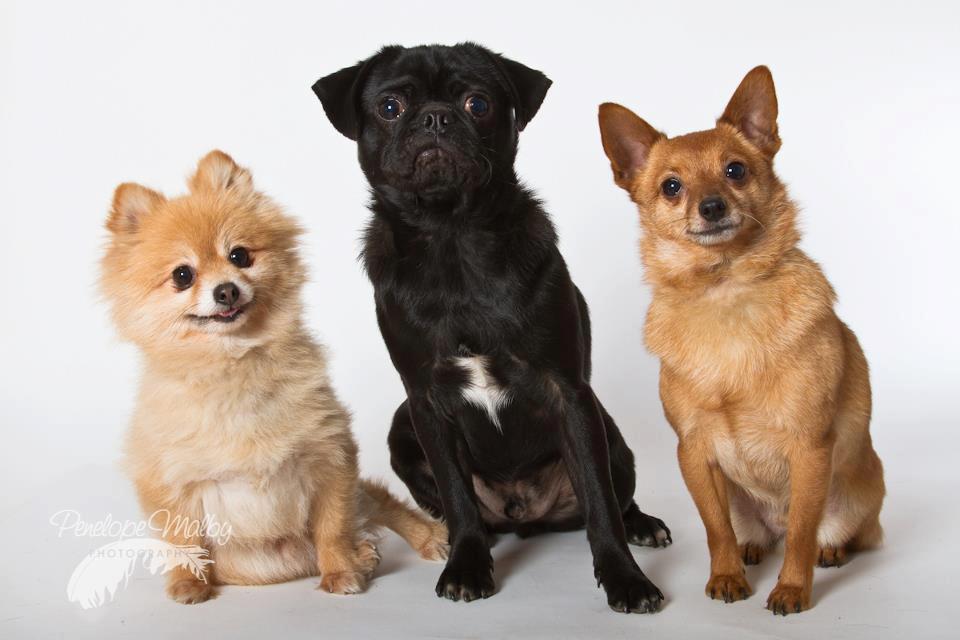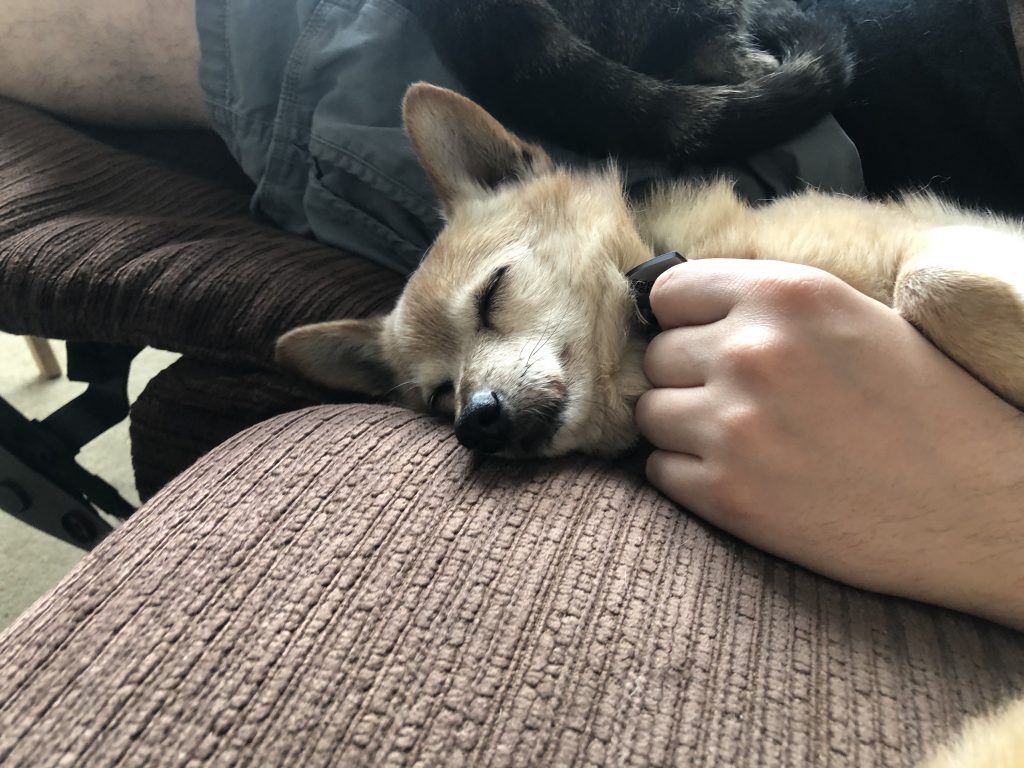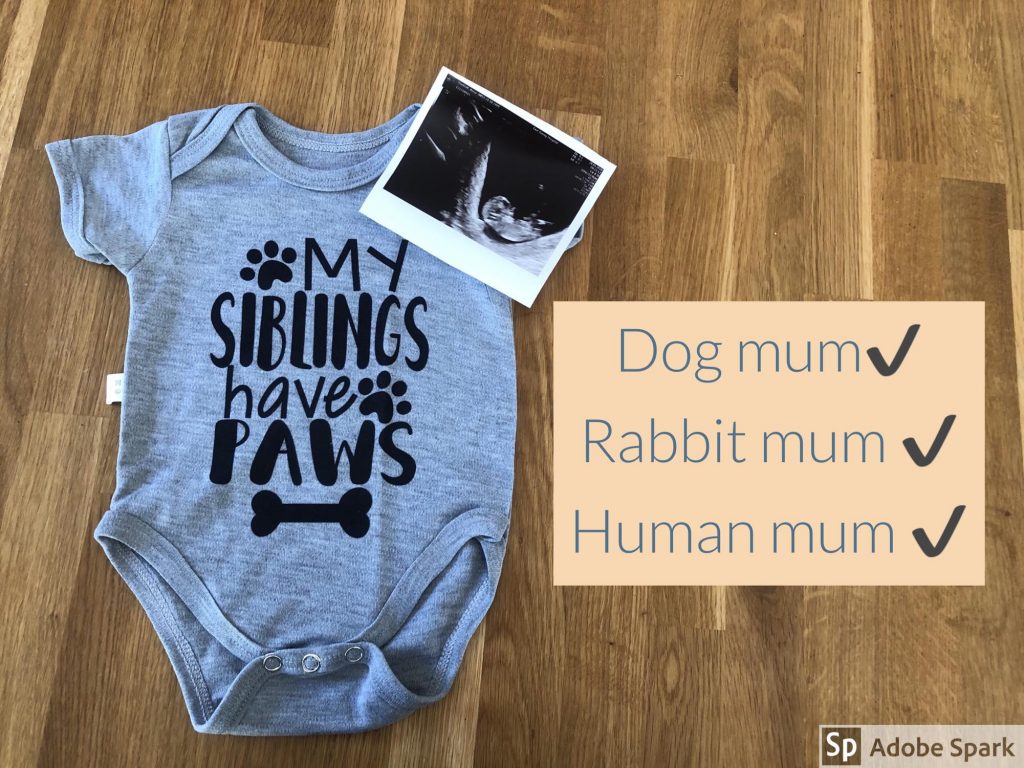If you are reading this blog because you have just found out you are pregnant – congratulations! It’s such an exciting time and there are so many wonderful things to look forward to, but if you are like me, you are probably wondering how your dog (or in my case, dogs) are going to cope with the new arrival. This blog explains how we prepared our dogs before our baby arrived.
It’s never too early to start training
After the initial shock and excitement wore off from getting that positive pregnancy test, my next thought went to my dogs. How are they going to cope with a baby? They have not been around children or babies – in fact, there are no kids in our immediate family and although they are all rescue so may have been around children before I adopted them, that would have been 8-10 years ago so it was definitely time for a refresher course for them!
We have three dogs. Eric, an 8-year-old pug, Nacho, a 10-year-old Chihuahua x Dachshund and Tommy a 10-year-old Pomeranian.
There is no way our dogs are going anywhere – they are part of the family and we love them so much. Our only option is to train them and get them used to the idea and we have 8 months to do that – there is no time like the present!

Babies change your routine
My dogs have had pretty much the same routine for the past 8 years. Breakfast at 6 am, walk in the early morning, nap time, playtime, dinner and then more sleeping. Babies change everything so I wanted to change their routine up. As I didn’t know how sleep deprived we were going to be in the early days (I’m going to guess it will be a lot!), this was the first thing I wanted to address. Our pug, Eric, is a huge foodie. He would start yipping for breakfast anywhere from 5:30 am and as my husband, Lee leaves for work early, he would get up when Eric barked, feed him and then go to work. This was the first thing we wanted to tackle as the idea of him yipping at the crack of dawn if we had been up all night with the baby did not sound fun!
To be honest with you, our other two dogs Tommy and Nacho are brilliant in the morning. Nacho sleeps in a crate which he loves and Tommy sleeps in the lounge with him. Neither are that bothered about food and will sleep in until we get up quite easily, but Eric is another story.
Eric sleeps in a crate in the kitchen. We have a large kitchen window that doesn’t have a blind, so in the summer months when it gets lighter earlier, Eric will bark as soon as the sun comes up. The first thing I did was to purchase a cover for his crate. Although it’s not a blackout one, it does keep it darker which helps. You could use a blanket rather than a cover however, the crate covers have ventilation windows, zips at the front to allow you to access the door and they look much smarter than a blanket.
The first few days of training were testing, to say the least. Eric would begin yipping like clockwork at 5:30 am and he woke us up of course, but we stayed in bed until we wanted to get up. Then, we went downstairs and let him out the crate and into the garden. Of course, he was frantic and excited as he was expecting food, but we didn’t give in. We ignored him and set about our morning routine of making breakfast, brushing our teeth and showering. Eric was confused, but eventually sat in his bed and went to sleep. When he was calm, we got him to sit on his mat and wait, before feeding him.
As babies can be very unpredictable, we change what time we feed him. Sometimes its before I shower, other times it’s after his walk – but it’s when we feel like it. We didn’t want something else to become a trigger for him to start barking, as he would think “after she has brushed her teeth, I get fed” as he is a smart dog and would make the connection.
After 8 years of Eric barking at 5:30 am, he now easily sleeps in and is calm for his breakfast – something I never thought would happen! Now onto the next issue, walkies!

The bark before a walk
Doing fostering and dog boarding for many years, I will admit my own dogs slipped into some bad habits and I used the excuse of the guest dogs making training difficult for me. As soon as I put my shoes on and touch their lead, the house becomes filled with a chorus of barks and excitement, resembling Battersea Dog’s home!
I usually walk Eric and Nacho and then Tommy on his own as he can’t go as far as the other two (don’t you dare tell him I said that though – he would be furious!). However, old age is creeping up pretty quickly on Nacho and with several health issues already, I have decided to walk him and Eric separately. It was getting to the point where Nacho could only go a short distance and this wasn’t fair on Eric who needs to run and go a fair amount further. So this meant I not only had to tackle the barking before the walks, but I also had to get the boys used to walking separately (and being quiet at home whilst they waited their turn).
The first step was to desensitise them to me putting my shoes on and getting my bag from the cupboard under the stairs. Several times a day I would put my shoes on and then sit down and watch tv, or put my bag on my shoulder and do the washing up. Of course, they barked, but me putting my shoes and getting my bag no longer became a queue for them to signal a walk and soon enough, me touching either of these objects became boring to them and they no longer reacted. I didn’t react at all when they barked, I just carried on about my day and got on with things.
Now I had to desensitise them to their harnesses and leads which took a little longer. I started by putting Nacho and Tommy behind the baby gate as Eric can be a bit of a bull in a china shop when he’s excited and as these two are much smaller and frailer than my stocky pug, I figured this was the best option. It also meant I could focus on one dog at a time. I started by touching Eric’s harness, and if he barked, screamed, whatever, I went and stood in the kitchen, with my arms folded – very boring to a dog. I repeated this until I could pick up his harness without a reaction, and then slipped it over his head. He would bark and scream in excitement, so I would remove the harness, walk to the kitchen and fold my arms. I would only move when he was calm and quiet. I repeated this until he could wear his harness fully clipped and with his lead attached in silence.
Once he was wearing the harness, I would then go and sit down. This confused him greatly, but I didn’t want him to connect the harness with going out and excitement. We would repeat this exercise a few times a day at different times, until putting the harness on became a mundane task that no longer triggered screaming and hyper behaviour.
Now it was time for the next step – approaching the door with his harness and lead on. I held the lead in one hand and walked him towards the door and yep, you’ve guessed it, Eric would leap and scream. I didn’t want to remove the harness and lead at this point as this would take too long for him to associate barking at the door with us not leaving, so I would drop the lead and walk to the kitchen, fold my arms and wait for calm and quiet. I repeated this until we could leave the house without him acting up, but as soon as we walked onto our drive, he would bark. As soon as he barked, I turned around, marched him back indoors, dropped the lead and folded my arms in the kitchen. Eric is a pretty smart dog and got the hang of it pretty quickly, Nacho took a bit longer and we are still working on it now but he is much better.
Less attention/breaking bond with me
As I have spent so many years working from home, my dog’s spend a huge amount of time with me. They do love Lee a lot, but all three are definitely more bonded to me and we needed to get them used to spending some one on one time with Lee, as well as on their own.
Lee has now taken over feeding them in the morning and evening. He also walks the boys on their own without me – Nacho really struggled with this at first. I don’t think Lee has ever walked Nacho so this was a huge thing for him and he kept looking back for me, but Lee praised him and offered treats to show him being with him was a good thing.
I have also tried to break the habit of them getting lots of attention from me throughout the day. They used to be able to jump on the sofa when they wanted and not only does that mean they are even closer to me all the time, I was also worried about them jumping up onto the baby. Rather than being allowed on and off the sofa as they please, they now are only allowed up by invite only. This was fairly easy, should they jump up, I would ask them to get down again and they picked it up quickly. We have also started giving them chew toys and treats (Dentalife or Kongs stuffed with food are good options) to help them realise that being on their own is a good thing, and they can find ways to entertain themselves without us.
Of course, our dogs still get lots of cuddles and one on one time, but I didn’t want them to associate the baby with less attention and cuddles from me, so by starting it now it should be second nature by the time baby arrives.

Door barking
Another bad habit our dogs have gotten into is barking at the door. I know most dogs bark at the door, but our dogs (mainly Nacho) bark at the slightest noise and they will go on and on for a long time, which is annoying. This habit needed to be broken as they are all as bad as each other for this.
We started with a pot of treats each and Lee stood by the front door and knocked on it. They are barked, but as soon as one was quiet, I gave them a treat. We repeated this several times by knocking and ringing the bell. Once they understood what was going to happen, we started to increase the time between the quiet and the treat, and we also added the queue word ‘quiet’. It would go like this – knock on the door, dogs bark, wait until they are quiet, wait a few seconds, say ‘quiet’ and treat.
The time between the quiet and treat is made longer each time, by a second or so. I don’t mind the dogs having a little bark at the door – it’s security for us and it’s what dogs do, but it meant we could get them to be quiet after an appropriate amount of time.
Barking at other dogs
Another issue we have are the dogs barking at other dogs (and people… I’m looking at you, Tommy!). Eric on his own is perfect to walk and loves everyone, canine or human, so it was really only Tommy and Nacho who needed training in this area.
The first thing we did was, taking them out one at a time, hunt for other dogs and people. We started with the other just quite far away and as soon as either dog looked at the dog, we would treat them. We had to be careful to do this before they barked because I didn’t want them to think barking was acceptable behaviour. At this point, I was trying to associate other dogs and people with food and praise.
We repeated this for a while, with dogs getting closer. Once they started to see other dogs, they would naturally look to me, expecting a treat. When they were quiet and looked at me, I would say “dogs” and treat them. Eventually, I would increase between the pause and praise, but this is a slow process that should not be watched. If they got confused or barked, I would walk them away and try again.
Babies = treats!
As I have said, none of my dogs has had direct contact with a child in the time I have owned them. Whilst I would never advocate leaving a dog and a baby or child alone together for any length of time, I felt it was appropriate to begin to teach them that little people mean good things happen to them.
When we are out and about and we see babies in prams, kids on bikes, kids shouting and playing, I give the dogs a treat each and praise them. This way they will start to associate little kids with reward, praise and food!
As kids and babies are a new concept for our dogs, we went online and found recordings of baby noises. We began playing these noises quietly in the background at various points in the day. None of our dogs reacted to the noise, so we started to increase the volume until it reached how loud a screaming baby would be. We played the sounds when the dogs were playing, eating and sleeping so it became a normal noise they would hear throughout the day, which is what it will be for us in December!
We will continue these exercises over the next few months and add more as the pregnancy develops and have begun training the cats too!
Check back for part 2 in a few months where we start introducing the baby’s furniture to the dogs.


Very helpful suggestions for barking. I really enjoyed reading about your experiences. I have tried some of the behaviors, folding arms and turning away until the barking stopped. It was very successful. Thank you.